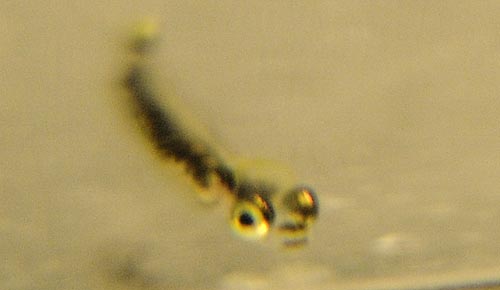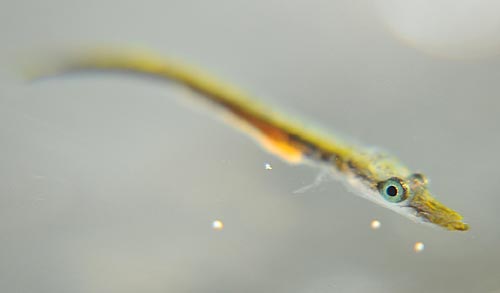 |
Fascinating New Babies Now at Seaside Aquarium, N. Oregon Coast
Published 04/21/2014

(Seaside, Oregon) – The ocean has a habit of coughing up the strangest things, and sometimes they're still alive.(Above: a baby moon jelly. All photos courtesy Tiffany Boothe, Seaside Aquarium.)
Case in point: Seaside Aquarium made some discoveries on a north Oregon coast beach a while back that have now meant a visit from the stork, bringing new baby creatures to the legendary attraction.

A handful of mystery eggs found on the beach on February 17 started hatching a couple weeks later. They were found attached to a large entanglement of bull kelp that had come ashore at Seaside. Aquarists there noticed a fish had laid eggs which had then fixed themselves to the kelp.
Seaside Aquarium staff had no clue what sort of eggs they were. So, they simply waited for them to hatch.

Even then, on March 5, the fish were still too small to be accurately identified. But as they steadily grew, feeding on brine shrimp, staff were finally able to make an ID for the little ones on April 15.

“We took a close look at them and were able to identified them as Tubesnouts (Aulorhynchus flavidus),” said the aquarium's Tiffany Boothe. “Over the last few weeks we have posted the fish on our Facebook Page and no one was able to guess our Mystery Fish's identity (even our aquarists). But it was fun trying.”
Tubesnouts can be found in local bays and estuaries. They generally grow up to 7.5 inches in length and feed on small invertebrates.
The Seaside Aquarium is also boasting other little newborns: baby jellyfish. Their moon jellies recently gave birth, in a sense.

Boothe said moon jellies have two main stages in their life cycle: the polyp stage and the medusa stage. The polyps (above, which in appearance resemble sea anemones) release ephrya, essentially baby jellies.
On April 17, they saw their polyps releasing ephrya.

“With any luck we will be able to raise them,” Boothe said.
Moon jellies are translucent, and with their limited movement capabilities only drift with the currents. They feed by stinging small plankton and mollusks with prickly little tentacles, then moving the their food into their body for digestion. They also feed on crustaceans, tunicate larvae, protozoans, diatoms, fish eggs and other similarly small organisms.
Moon jellies do not have breathing organs such as gills or lungs, but instead diffuse oxygen from water through a thin membrane.
They are essentially found all over the Earth’s oceans, but mostly in the upper hemisphere, living in temperatures that are typical of the oceans off the western U.S. and Pacific Northwest.
Seaside Aquarium is on the Prom in Seaside. 503-738-5211.
More about the area at the Seaside Virtual Tour, Map.
More About Seaside Oregon lodging.....
More About Oregon Coast Restaurants, Dining.....
LATEST Related Oregon Coast Articles
Whale Body Parts Found on Oregon Coast - Two Whales Strand on Washington Coast |
Secrets of the Season |
Unusual Travel Articles TravelParanormal.com allows you to submit your own creepy tale or debunk one - or see up-to-the-minute news headlines about travel and the paranormal. News Headlines from All Over Oregon Need to scan Oregon headlines? Constantly updated news from all over Oregon: a comprehensive, up-to-the-minute display of news headlines from a variety of media Oregon Coast Oceanfront Lodging, Hotels, Rentals |
Back to Oregon Coast
Contact Advertise on BeachConnection.net
All Content, unless otherwise attributed, copyright BeachConnection.net Unauthorized use or publication is not permitted







































